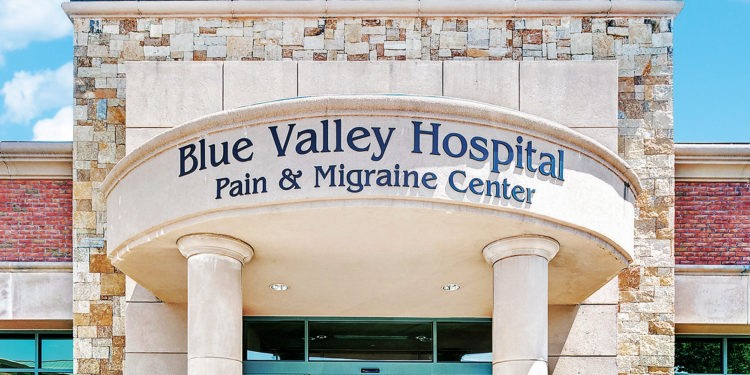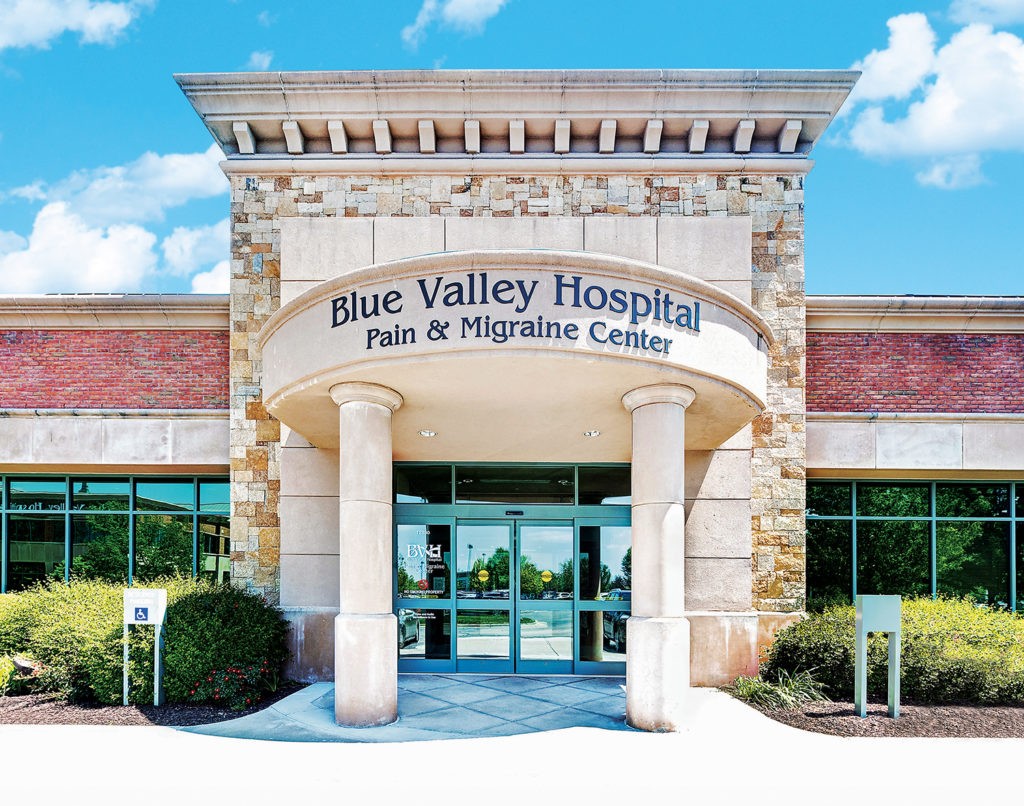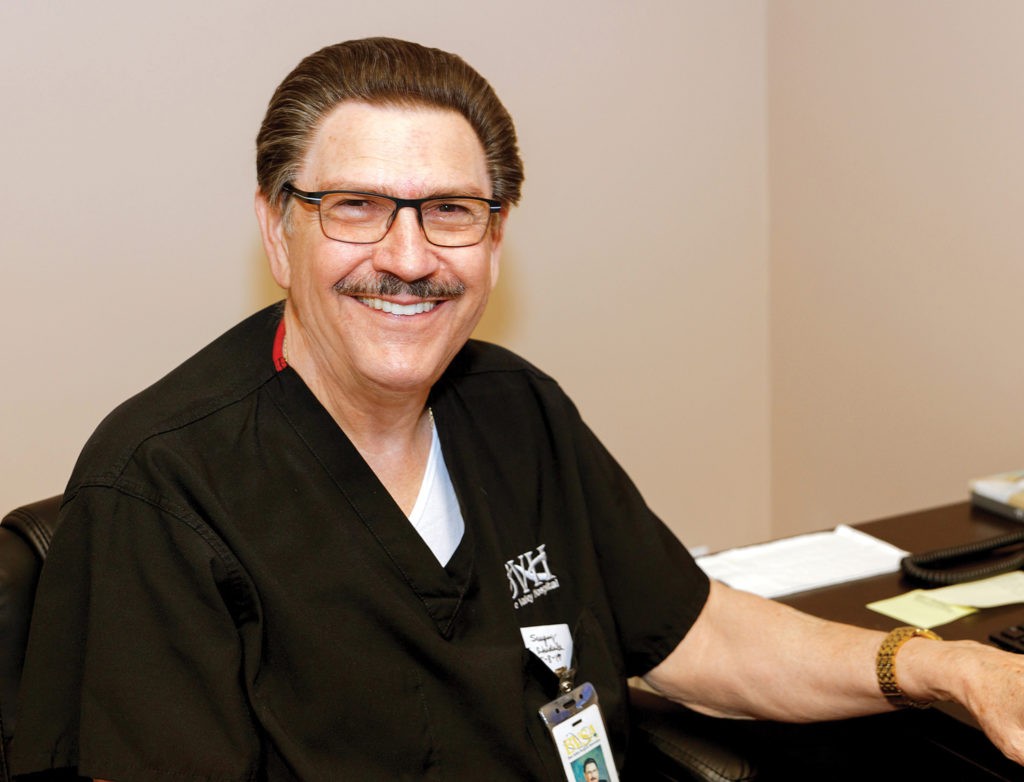The Pain & Migraine Center at Blue Valley Hospital

Helping Patients Transition from Suffering with Pain to Overcoming It
Blue Valley Hospital offers one of the Largest Pain Clinics in the Kansas City area.
“This is the pain clinic I’ve dreamed of being a part of my whole career,” emphasized Anthony LaSalle, DDS, Director of the Blue Valley Hospital Pain & Migraine Center, which opened in Overland Park, Kansas last December. In 2014, Blue Valley Hospital began providing interventional pain management services to help the increasingly growing number of people throughout the metro area suffering from chronic pain. Because so many patients turn to Blue Valley Hospital from surrounding areas, this motivated the expansion of the hospital’s services to offer this dedicated pain center, which is attracting patients in record numbers from all over the metro area.

“Blue Valley Hospital is an acute care, multi-specialty, fully accredited facility,” expressed Dr. LaSalle, noting the hospital provides services in bariatrics, pain management, orthopedics, chiropractic care, podiatry and general surgery. Blue Valley Hospital is also home to Dr. William O. Reed, Jr., a prominent orthopedic surgeon who primarily practices minimally invasive spinal and upper extremity surgeries.
“He is one of the top three leaders in total lumbar disc replacements in the United States, both in volume and care outcomes,” noted Dr. LaSalle.
Because of its dedication to top-quality surgical and post-operative care with a keen focus on the best possible outcomes and unparalleled patient satisfaction, the hospital is truly a standout within the community.
“We have roughly fifty clinics throughout the area that refer patients to the Pain & Migraine Center,” said Dr. LaSalle. “We service patients from many different areas, including community health centers and rural health clinics. Our door is open to all those who need our services.”
Dr. LaSalle holds many titles and honors including Diplomate of the American Academy of Pain Management; Board Certified by the National Board of Anesthesiology; past Secretary of the Greater Kansas City Society of Pain Management, past Assistant Professor of Anesthesiology at the University of Kansas Medical Center; past Director of Anesthesiology at Overland Park Regional Medical Center; past Medical Staff President at Cushing Memorial Hospital; and past member of the Medical Executive Committee at Overland Park Surgery Center. With a long-standing career in interventional pain management, Dr. LaSalle is excited about the center and the promise of enhanced quality of life it affords the patients.
“Blue Valley Hospital offers one of the largest pain clinics in Kansas City,” he explained. “We have expanded our facilities, all of which are at ground-level with curbside parking. We see on average 1000 patients per month in our 11 examination rooms. We also have x-ray onsite and two suites for interventional procedures with two fluoroscopy machines that allow us to see inside the body. We only use state-of-the-art equipment.” Knowledgeable in all aspects of pain and pain management, the medical experts here fully understand their patients and are committed to providing the best in care and service to help them realize a pain-free life.
Sadly, pain is a four-letter word that affects an estimated 100 million Americans on a daily basis and the most common types of pain include low back pain, severe headache or migraine pain, neck pain and facial ache or pain. By employing interventional treatments, patients can realize long-term pain relief along with decreased dependency on opioid pain medications. As a result, an improved quality of life becomes within reach.

Dealing with painful chronic headache conditions is a daily occurrence for millions of people across the United States. Approximately 45 million men and women in America suffer from chronic headache disorders, and of those in excess of three million have turned to emergency services to treat severe headaches at least once. In excess of 60% of patients have abandoned their prescription medications, primarily due to rising costs associated with these. Further, such medications also come with a host of unpleasant side effects. Patients deserve and need something better.
Among the exciting services offered at Blue Valley Hospital Pain & Migraine center is the expansion of its specialty treatment options for chronic headache and migraine sufferers. This includes treatment for a wide spectrum of headaches, including vascular migraines (chronic and acute), vertex, cluster, tension headaches, transformed cervical migraine headache and vagal headaches.
A new intervention offered at the Pain & Migraine Center for those suffering from chronic headaches is the SphenoCath® Medical Device. Awarded with a US Patent in 2013, this device is referred to as an “Apparatus System and method for treating atypical Headaches.”
So, how does it work? First of all, it is important to understand what the Sphenopalatine Ganglion is, also known as the SPG. The SPG is a collection of neurons inside the head, located outside of the brain. It is exposed to the outside environment due to its proximity and connection to the nasal mucosa. The SPG is at the helm of numerous pain-associated issues in the head, such as migraine, tension and cluster headaches, as well as those headaches that present with mixed symptoms. Through the use of something called an SPG block, medication can be administered to the SPG, which diminishes the nerve impulses in an effort to provide effective and long-lasting pain relief.
Traditionally, an SPG block meant that the patient had to be sedated to allow the doctor the ability to insert a Q-tip –like applicator through the nasal passage or insert a long, thin needle through the side of the head to administer the requisite medication to the SPG. Effective? Yes. Risky? Undoubtedly. The SPG block procedure has actually been in existence since the early 1900s, and has historically proven to be effective. However, due to the highly invasive nature of the procedure and the discomfort it brought to patients, many physicians shied away from offering it.

Until the introduction of the SphenoCath®, an FDA-approved device purported to offer 70% to complete pain relief immediately.
“This is designed to be safe and relatively painless,” said Dr. LaSalle. “We simply insert a catheter into the nose high up into the nasal passages. Once it is in the right location, medication will be delivered through the spigot on top of the catheter to anesthetize the SPG, thereby breaking the cycle of pain and giving the large ganglia of nerves a rest.”
Dr. LaSalle indicated this procedure is done on an outpatient basis using local anesthesia only. In addition to immediately relieving the patient of pain, there is also potential for sustained pain relief and subsequent decrease of medications taken by the patient. Due to Dr. LaSalle’s training as a dentist and anesthesiologist, he is well-versed in the anatomy of the head and neck and as a result, he receives numerous referrals from oral surgeons for patients to undergo this procedure.
“The SphenoCath® device is truly revolutionary,” he smiled.
For those who live with chronic pain, the effects it has on both their physical and emotional health are highly detrimental. Chronic pain can be attributed to sleep problems, extreme exhaustion simply from the pain alone, and lack of physical activity, which ultimately can lead to cardiovascular and musculoskeletal decline. From a mental health perspective, chronic pain has been linked to depression and even isolation from friends and family.
Through its comprehensive approach to treating pain, the Pain & Migraine Center at Blue Valley Hospital targets and treats chronic pain that has not been resolved by other modalities. The experienced pain specialists create an individualized treatment plan for each patient so that his or her specific condition is thoroughly evaluated and addressed. Through their full on-site radiology services, these specialists can offer comprehensive diagnostic imaging as well. Loosely translated, this means the experts at the Pain & Migraine Center are 100% focused on providing the best interventional treatment options for each patient with the goal of long-term relief.
Recognized for its many services and therapies, Blue Valley Hospital offers interventions for a variety of chronic pain issues, including nerve blocks, epidural steroid injections, lumbar discography, facet joint injection, joint injection, radiofrequency ablation, spinal cord stimulation, chiropractic manipulation under anesthesia and percutaneous disc decompression. Another interventional treatment the center offers for those suffering from chronic migraine headaches is Botox.

In addition to Dr. LaSalle, the pain management team consists of some of the best and most experienced pain management specialists in the area: Lane Peterson, DO; Deborah Ruggles, MD; Dwayne Jones, MD; Joseph Conigliaro, DC; Alma Navato, MD; Mark Pinkerton, MD; and Mark Allen, MD. The center also employs physician assistants and nurse practitioners.
Coupled with his work as Clinical Director of the Pain & Migraine Center and also Medical Staff President, Dr. LaSalle keeps a steady, yet highly enthusiastic, gaze on the horizon in terms of future growth.
Blue Valley Hospital is a Missouri Medicaid provider and can receive patients for consultation, evaluation and treatment.
“We also provide services for veterans, Medicare patients, TRICARE for Life, and patients with private insurance” indicated Dr. LaSalle.
Providing pain relief for their patients is what inspires the healthcare providers at BVH Pain & Migraine Center on a daily basis.
“What we do is very rewarding,” he reflected.
For more information on the Blue Valley Hospital Pain & Migraine Center, go online at bluevalleysurgical.com; call 913.378.2100, or visit them at 12880 Metcalf Avenue in Overland Park, KS.




